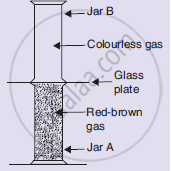Advertisements
Advertisements
प्रश्न
Name the three states of matter. Give one example of each.
उत्तर
The three states of matter and their examples are as follows:
- Solid: wood
- Liquid: water
- Gas: air
APPEARS IN
संबंधित प्रश्न
The mass per unit volume of a substance is called density.
(density = mass/volume).
Arrange the following in order of increasing density-
air, exhaust from chimneys, honey, water, chalk, cotton and iron.
Give a reason for the following observation.
Naphthalene balls disappear with time without leaving any solid.
Give a reason for the following observation.
We can get the smell of perfume sitting several metres away.
Which of the two diffuses faster : a liquid or a gas?
A bottle of perfume was opened in a room. The smell of its vapours spread in the entire room. Name the property of gases which is responsible for this behaviour of perfume vapours.
Fill in the following blank with suitable words :
Solid, liquid and gas are the three ........................ of matter.
What does the diffusion of gases tell us about their particles?
Look at the diagram on the right side. Jar A contains a red-brown gas whereas jar B contains a colourless gas. The two gas jars are separated by a galas plate placed between them
- What will happen when the glass plate between the two jars is pulled away?
- What name is given to the phenomenon which takes place?
- Name the brown gas which could be in jar A.
- Which is the colourless gas most likely to be present in jar B?
- Name one coloured solid and one colourless liquid which can show the same phenomenon.

The substance X normally exists in a physical state which can flow easily but does not fill its vessel completely. It also turns anhydrous copper sulphate blue. When substance X is cooled excessively, it changes into a substance Y which has a fixed shape as well as a fixed volume. If, however, the substance X is heated strongly, it changes into a substance Z which has neither a fixed shape nor a fixed volume.
- Name the substances (i) X (ii) Y and (iii) Z.
- What is the process of conversion of X into Y known as ?
- At which temperature X gets converted into Y ?
- What is the process of conversion of X into Z known as ?
- At which temperature X gets converted into Z ?
______ is not affected by gravity.
